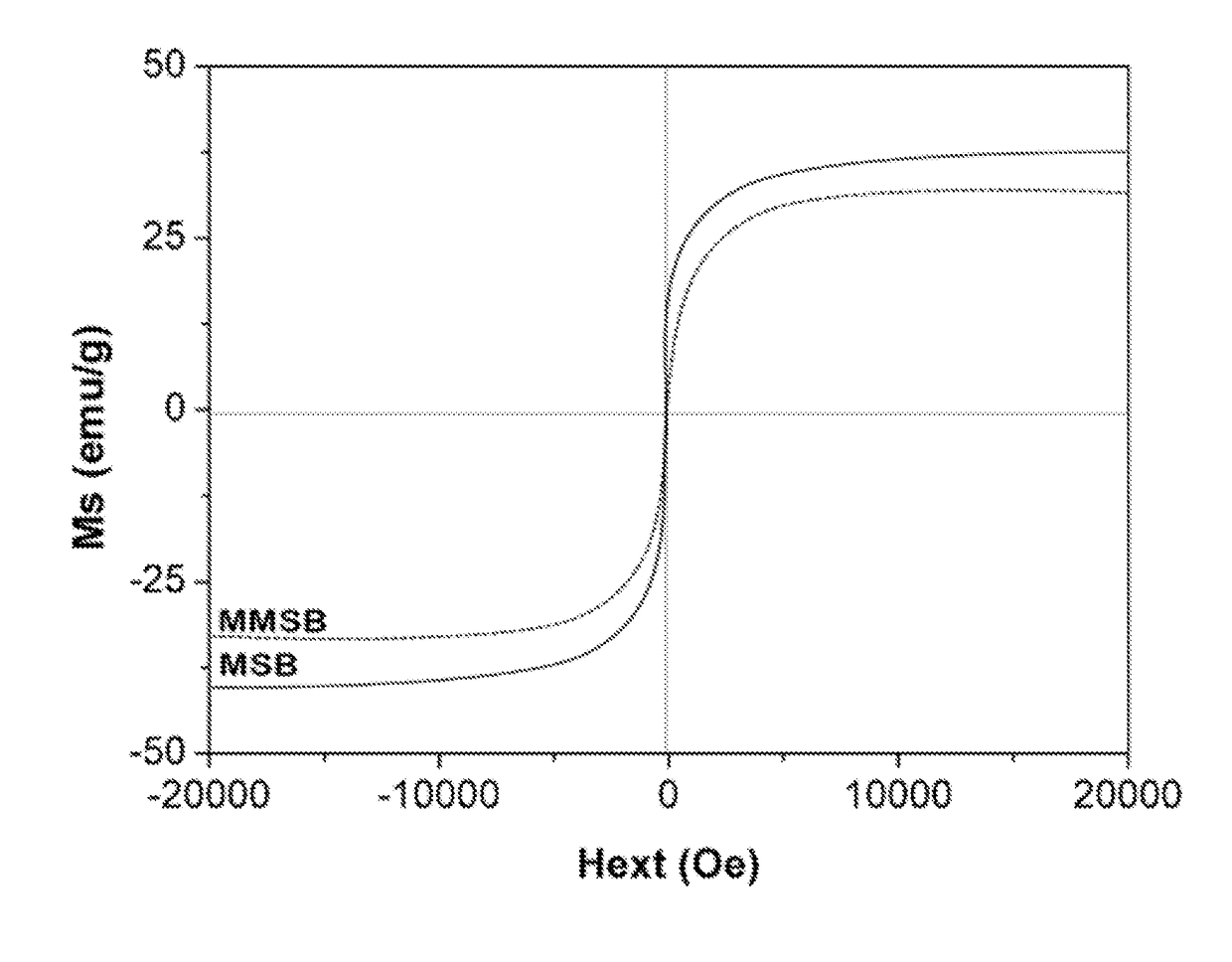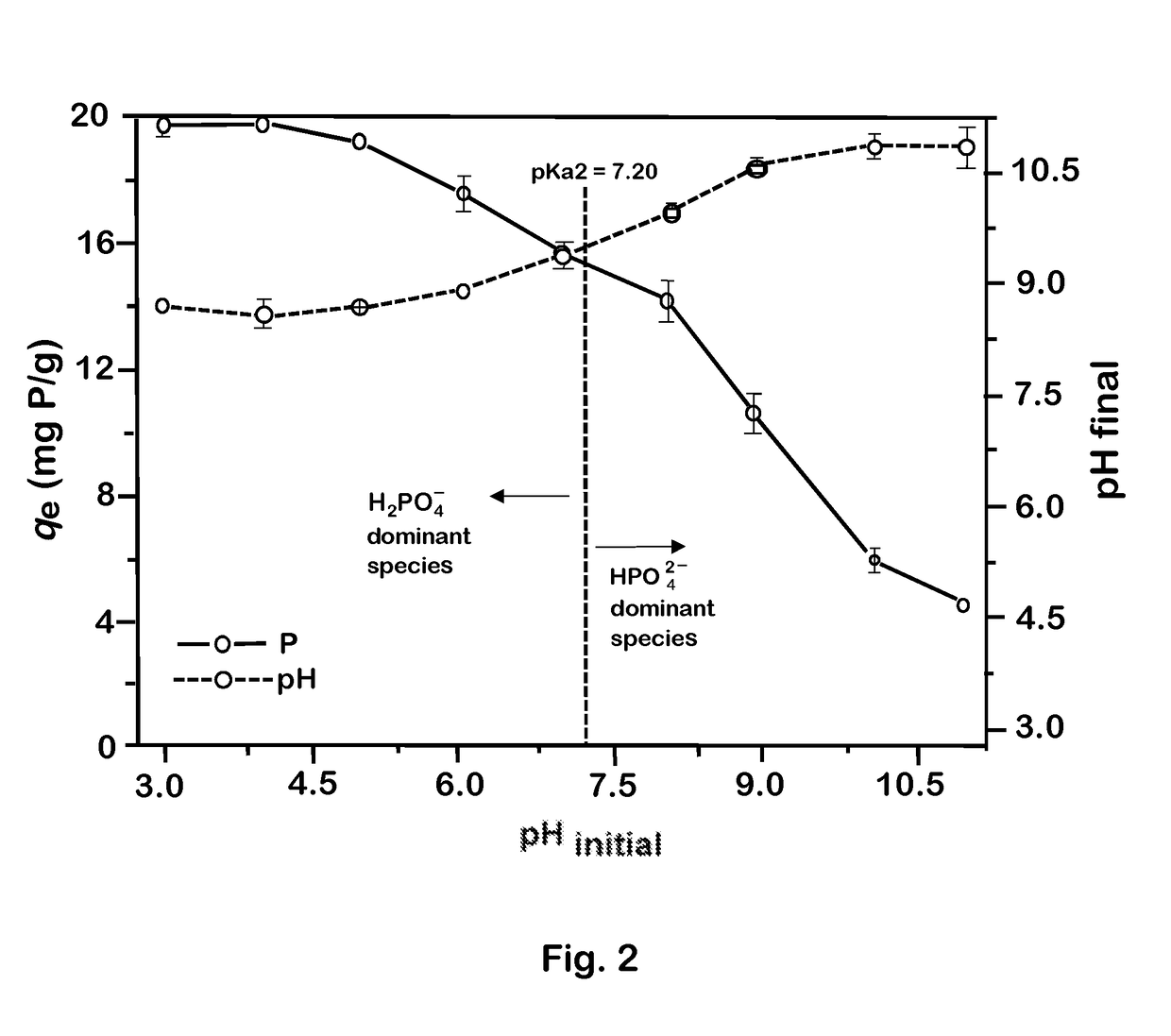Magnetic Metal Oxide Biochar Composite Particles, and Their Use in Recovering Pollutants From Aqueous Solution
a technology of biochar and magnesium oxide, which is applied in the direction of magnesium compounds, ferroso-ferric oxides, magnesia, etc., can solve the problems of increased toxicity, reduced water oxygen levels, and unhealthy phosphate levels in many waterbodies, so as to improve phosphate adsorption and strong phosphate sorption
- Summary
- Abstract
- Description
- Claims
- Application Information
AI Technical Summary
Benefits of technology
Problems solved by technology
Method used
Image
Examples
example 1
Collection and Biochar Preparation
[0032]Sugarcane harvest residue (SHR) was collected at the Louisiana State University AgCenter Sugar Research Station at St. Gabriel, La., United States. SHR comprises primarily leaves and tops of stalks. Sugarcane bagasse, or other sources of biomass, can also be used in the novel process as alternatives to, or in addition to sugarcane harvest residue. The SHR was cut into small pieces, less than about 5 cm, and was washed several times with deionized water (DW) (18.2 MΩ) to reduce dust. The cut, washed SHR was then oven-dried at 55° C. overnight.
[0033]The biomass is processed so that a majority of the biomass particles (by mass) preferably have a length (longest dimension) less than 1 mm; more preferably less than 0.5 mm; and most preferably less than 0.2 mm. In these prototype experiments, the oven-dried residue biomass was crushed with a high-speed rotary cutting mill, passed through a 0.12 mm screen, and then used for biochar preparation.
[0034]...
example 2
aracterization
[0038]Infrared spectra of biochar samples were obtained with a Nicolet iS50 Fourier transform infrared spectrometer (FTIR) (USA). XPS (X-ray photoelectron spectroscopy) spectra were obtained with a Kratos (Japan) AXIS Ultra DLD spectrophotometer using an Al K X-ray source (1486.6 eV photons). The C, H, and N content of the samples was characterized with an elemental analyzer (Elementar Analysen Systeme GmbH, Germany). After biochar samples were digested with concentrated sulfuric acid and hydrogen peroxide, their Mg and Fe fractions were measured by inductively coupled plasma-atomic emission spectrometry (ICP-AES, SPECTRO Plasma 3200, Germany). Magnetization curves for the samples were measured with a PPMS-9T vibrating sample magnetometer (VSM) (Quantum Design, USA) with a varying applied field±15,000 Oe at 298° K. Pore and surface characteristics of the samples were measured by N2 adsorption at 77° K using a V-Sorb 2800P analyzer (App-one, China). The BET surface area...
example 3
orption Tests
[0039]Batch experiments were conducted to examine and compare the adsorption efficiencies of SB, MSB, and MMSB in recovering phosphate from aqueous solution. Experiments examined phosphate adsorption as a function of both Mg content and aqueous pH. Other experiments examined the adsorption of pollutants, and the desorption of phosphate. In a typical experiment, 0.05 g of adsorbent was added to a polyethylene centrifuge tube containing 20 mL of 50 mg / L solution that had been diluted from a 1000 mg / L phosphate stock solution. The pH of the solution was adjusted between 3.0 and 10.9 using 0.1 mol / L HNO3 or NaOH before the centrifuge tubes were placed in a shaker operating at 120 rpm and 23.0±0.2° C. All experiments were performed in triplicate. After overnight mixing, each sample was filtered through a 0.22 μm GE cellulose nylon membrane filter. The concentration of phosphate in each filtrate was analyzed with a Thermo Scientific EVO 60 spectrophotometer (USA) at 880 nm (a...
PUM
| Property | Measurement | Unit |
|---|---|---|
| length | aaaaa | aaaaa |
| phosphate adsorption capacity | aaaaa | aaaaa |
| length | aaaaa | aaaaa |
Abstract
Description
Claims
Application Information
 Login to View More
Login to View More - R&D
- Intellectual Property
- Life Sciences
- Materials
- Tech Scout
- Unparalleled Data Quality
- Higher Quality Content
- 60% Fewer Hallucinations
Browse by: Latest US Patents, China's latest patents, Technical Efficacy Thesaurus, Application Domain, Technology Topic, Popular Technical Reports.
© 2025 PatSnap. All rights reserved.Legal|Privacy policy|Modern Slavery Act Transparency Statement|Sitemap|About US| Contact US: help@patsnap.com



